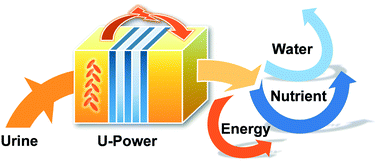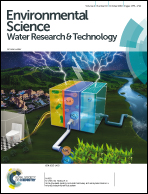Urine-powered synergy of nutrient recovery and urine purification in a microbial electrochemical system†
Abstract
This study demonstrates that the chemical energy contained in human urine can synergize the in situ nutrient recovery and purification of urine itself. This process was achieved using a urine-powered microbial electrochemical system named U-Power, which can provide a maximum power density of 21.3 W m−3via the degradation of fresh human urine. Urea hydrolysis was induced by anodic microorganisms and further accelerated by the electrical potential inside U-Power to provide ammonium and balance the pH in the anode. Driven by the electrical potential generated by U-Power, the NH4+ and PO43− contained in urine migrated into the high nutrient concentration recovery solution. On average, 93.8% of organics, 73.1% of nitrogen and 86.2% of phosphorus were removed, along with recovery concentrations of 1234 mg L−1 nitrogen and 101 mg L−1 phosphorus. Both the above purification and recovery processes require no energy input but output a satisfactory power density among all present urine treatment studies, together with an average current efficiency of 178% and a coulombic efficiency of 26%. By achieving the triple benefits of energy-positive recovery of nutrients from urine, avoiding the complicated and energy-intensive process of nutrient removal in downstream wastewater treatment facilities, and avoiding the energy and hygiene issues combined with the storage and reuse of urine, U-Power represents a promising tool to pave the way for a sustainable water–energy–nutrient nexus.

- This article is part of the themed collections: Best Papers 2018 – Environmental Science: Water Research & Technology and Best Papers from 2018 in the Environmental Science Family of Journals


 Please wait while we load your content...
Please wait while we load your content...